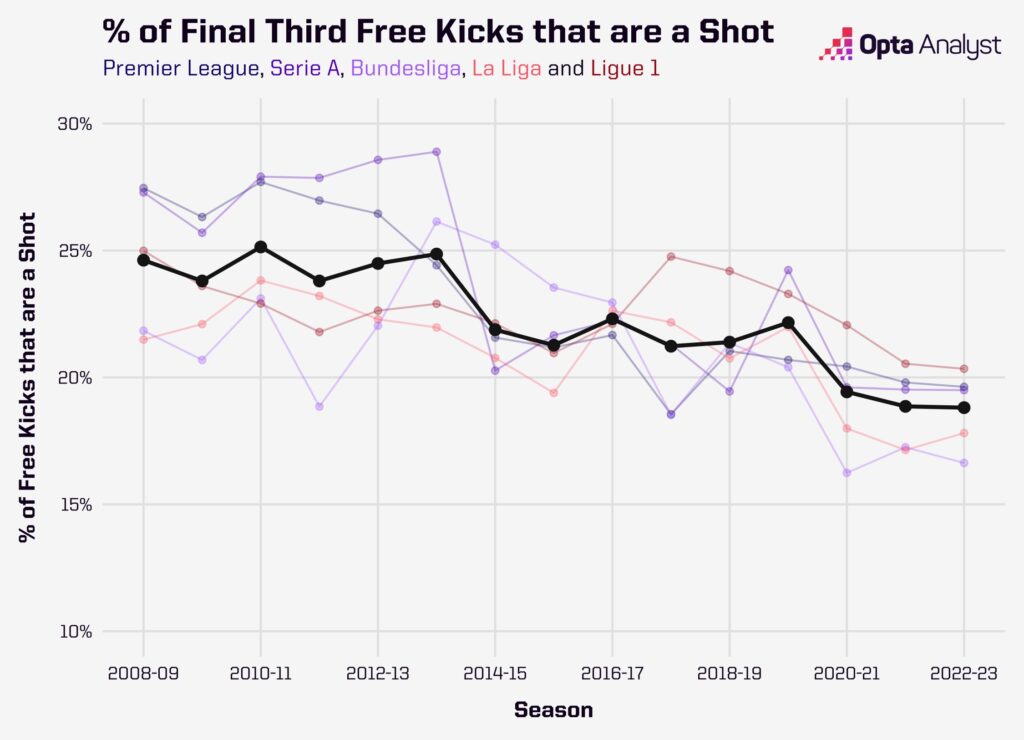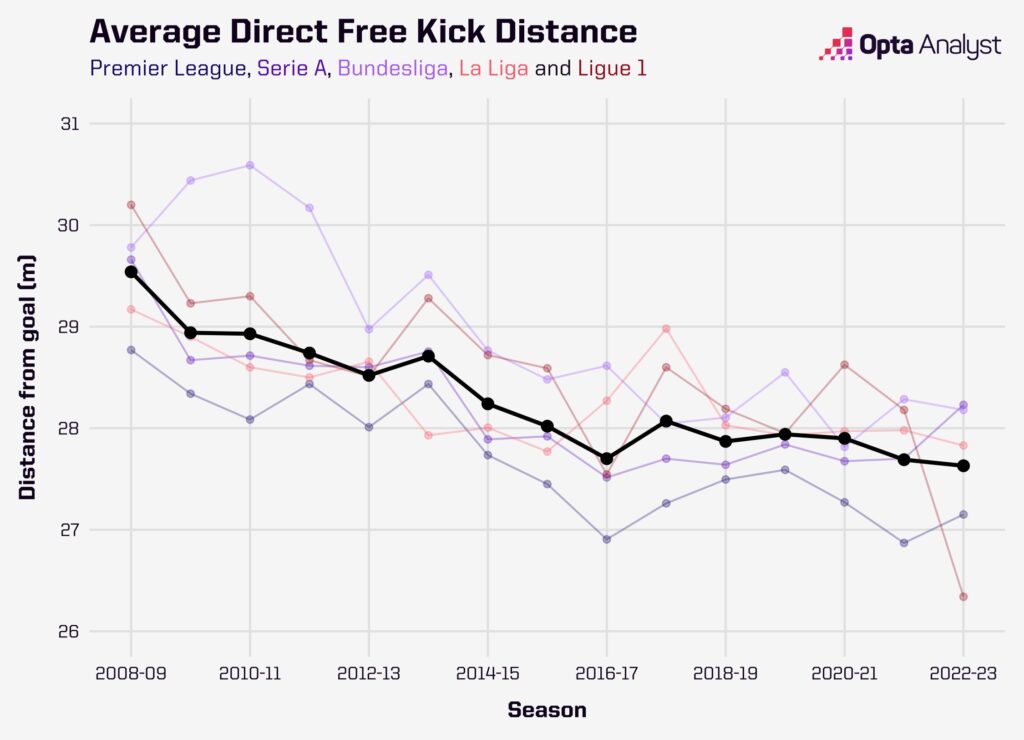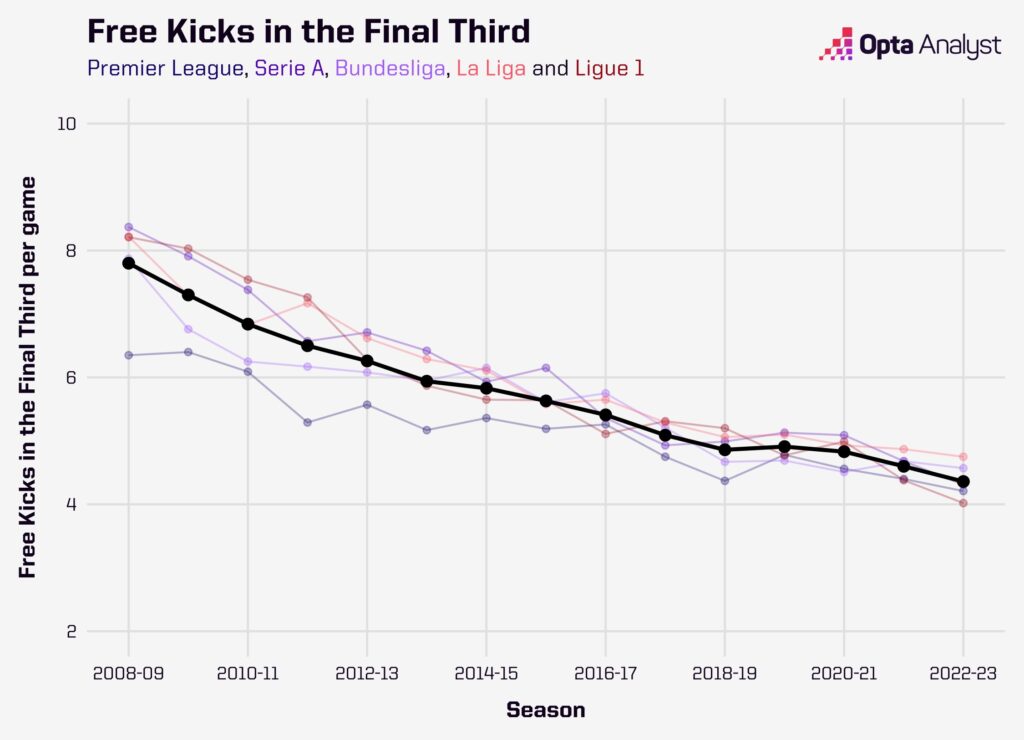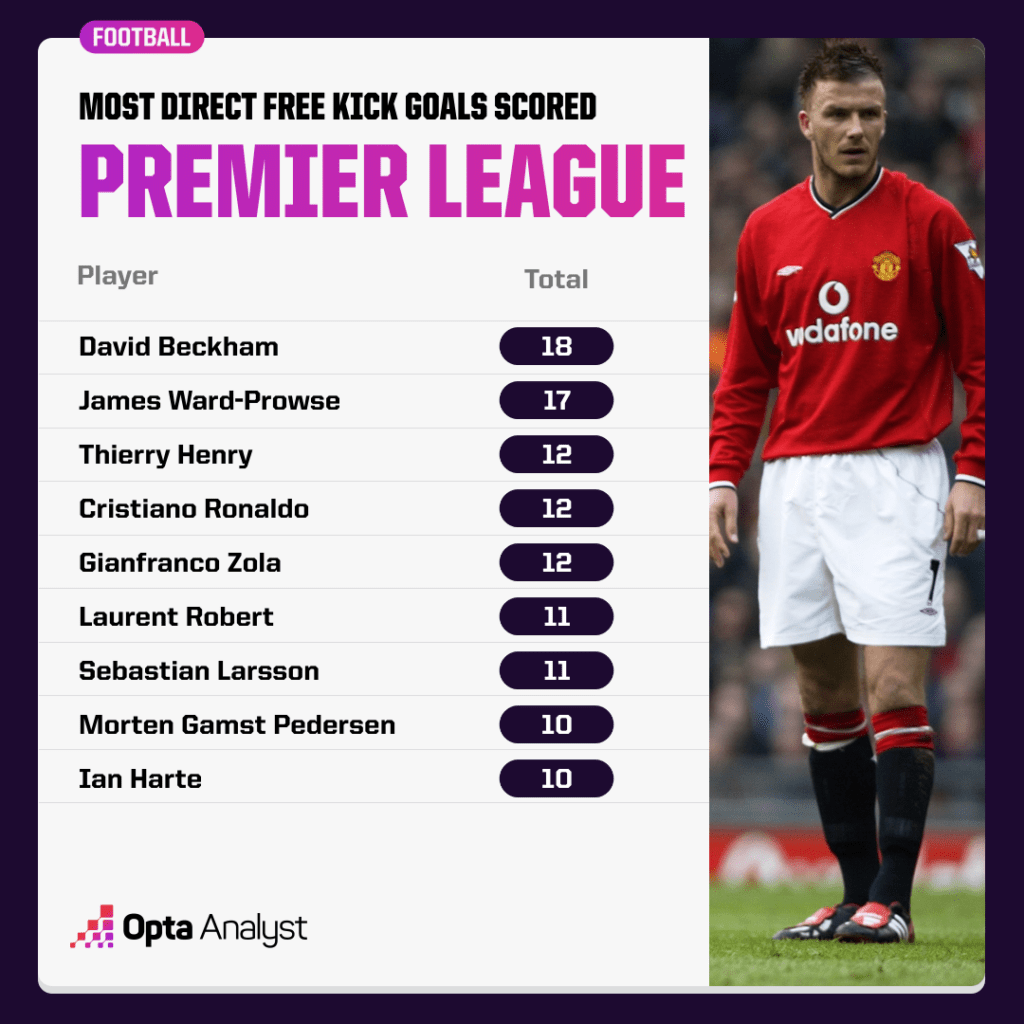Shooooooot! Or not? Free-kick shots have become less common across the major European leagues over the last 15 years, with teams preferring to pass or cross from final-third dead-ball opportunities. Is this further evidence of analytics changing the game, or is it a natural shift in the football landscape?
The next Premier League free kick that James Ward-Prowse scores will be significant for two main reasons. It will see the Southampton captain equal David Beckham’s all-time competition record of 18 – but that feat will be as notable for its improbability in today’s game.
You see, Ward-Prowse – along with the likes of Roma’s Paulo Dybala, Inter Milan’s Hakan Çalhanoğlu and one Lionel Messi – stands among European football’s few remaining true masters of a dying art. Since the 2008-09 season – when Opta started collecting detailed free-kick data for all of Europe’s top five leagues – there has been a discernible downward trend in the number of goals scored directly from free kicks.
Such strikes are an iconic part of the game – everyone’s got a favourite curler, dipper or straight-up rocket which instantly springs to mind – but they’re becoming a smaller part of it at the top level. That much is immediately clear from the numbers – but we’re here to take a deeper look at why this is happening.
Had Ward-Prowse commenced his Premier League free-kick taking duties even a couple of years earlier (he attempted his first shot directly from a free kick on 2 November 2013), he’d almost certainly have smashed Beckham’s record by now. Back in 2008-09, 27.5.% of Premier League free kicks awarded in the final third of the pitch were taken directly (i.e. shot from). Come 2022-23, that proportion has dropped to 19.6%. And, while that figure hasn’t decreased constantly season on season – there have been fluctuations – it hasn’t risen above 21.7% since 2013-14.
Meanwhile, in Serie A, the proportion of final-third free kicks taken directly peaked at 28.9% in 2013-14; it hasn’t been higher than 24.2% (in 2019-20, Cristiano Ronaldo’s most prolific campaign in the division with Juventus) since then. In fact, this term, the Italian top flight profiles almost identically to the Premier League: 19.5% of final-third free kicks have been taken as shots (compared to 27.3% in 2008-09).

This change has been less pronounced in the Bundesliga, Ligue 1 and LaLiga – but still, all three divisions display a noteworthy reduction in the proportion of free kicks taken directly between 2008-09 to 2022-23: 5.2%, 4.7% and 3.7% respectively.
Even Messi’s arrival at PSG in the summer of 2021 hasn’t made Ligue 1 any more of a free kick fun zone: this season and last season, the French top flight has recorded its lowest two proportions of free kicks taken directly since Opta started collecting such data.
So, what conclusions can we draw from this? Well, broadly speaking, great analytical advances and their increased embracing by clubs seem to have made teams more discerning with their free-kick choices. Even those sides fortunate enough to be blessed with a true dead-ball specialist may not be shooting from positions or angles which would have been prime ‘have a go’ territory 10 or so years ago. The rise in devotion to expected goals (xG) has led to overall average non-headed shot distance decreasing 3.3 metres over 15 years across the top five European leagues– and we’re seeing that phenomenon in microcosm when it comes to free kicks.
Where free kicks in the final third might once have been viewed as free hits, now teams treat them as genuine weapons with which to score – whether that be via a direct shot or creating a higher-value chance through a more intricate, ‘training ground’ move (although it should be noted that, generally speaking, the percentage of final-third free kicks which are crossed is similar now to what it was in 2008-09: around 66%). The median distance from which a final-third free kick is taken as a shot has gone down from 29.5 metres in 2008-09 to 27.6m in 2022-23, a sign that attitudes towards set-pieces are more meticulous than ever.

And they need to be, really. Markedly fewer free kicks are being awarded in the final third these days than was the case 15 years ago. The sharpest drops have come in Serie A (50% fewer final-third free kicks per game) and Ligue 1 (52.4%) – but the Premier League, LaLiga and the Bundesliga have all seen reductions of at least a third: 34.9%, 43.9% and 44.3% respectively. This season, for the first time since Opta started compiling such data, there have been fewer than four fouls in the final third per game in the top five leagues – and fewer than 18 fouls per game in any portion of the pitch.

What’s going on here, then? Well, we have two main theories.
First, referees are more lenient than they were a few years ago and let more go – knowing that VAR is, in principle, on hand to pick up any particularly bad fouls they might miss (not that that’s an entirely good thing, but let’s not open that extra-unappetising can of worms…).
Second, the increased prevalence of possession-based football and controlled build-up play – as opposed to a game built on counter-attacking (of course, there are still exceptions – and it can only be a good thing that the game will probably never become fully homogenised stylistically) – means teams draw fewer fouls in the final third – the basic hypothesis being that a defending player is more likely to mistime a tackle or lunge in desperately against opposition breaking at speed.
Curiously, though, every one of the top five European leagues have seen the average for fouls won in the final third of the pitch per game drop by between 20 and 30% over the last decade. As we’ve already noted, referees appear to have become more lenient since the advent of VAR (which was introduced to Serie A and the Bundesliga in 2017-18, La-Liga and Ligue 1 in 2018-19, and finally the Premier League in 2019-20) – but, certainly in England, they were told ahead of the current campaign to adopt a higher threshold for fouls and not whistle for a free kick at the slightest contact.
Somewhat soul-destroying though it may be, the sight of someone bending it like Beckham – or, more contemporarily, knuckleballing it like Ward-Prowse – is getting rarer.
Exhibit A: across the last three seasons in the top five leagues (so 15 separate campaigns), there has been an average of 15.4 direct free kick goals per season – and just the one instance of more than 20 in a season (23 in Serie A in 2021-22). To put into context just how dramatically this aspect of the game has evolved, that’s more than half the average across the first three seasons of the timescale we’re concerned with (33.2). Between those two three-season periods, that’s a massive reduction of 53.6% in the number of free kicks scored in the top five leagues.
Whether directly linked to the shift in attitudes towards free kicks or otherwise, the number of free kick specialists does seem to have diminished in recent years. Case in point: Ward-Prowse has scored 15 of the 93 direct free-kick goals in the Premier League over the last five seasons. Leicester’s James Maddison has scored eight of the other 78 – meaning the two namesake England internationals have accounted for almost a quarter of all direct free-kick goals in the world’s best league since 2018-19.
Kieran Trippier has scored four free kicks since returning to English football with Newcastle 15 months ago – his first four in Premier League, in fact. As such, Maddison and Manchester United’s Christian Eriksen are the only two current Premier League players within 10 of Ward-Prowse’s overall total of 17 (both currently sit on eight, and Eriksen hasn’t added to his tally since making his momentous comeback with Brentford in February last year).
By contrast, the Premier League careers of seven of the other 12 players with eight or more direct free-kick goals in the competition overlap by at least four seasons. They are: Beckham (17), Thierry Henry, Gianfranco Zola (both 12), Ian Harte (10), Nobby Solano, Jamie Redknapp and Frank Lampard (all nine). Additionally, the Premier League careers of those seven plus Laurent Robert (11) overlapped by at least three seasons – which also applies to another, largely different set of seven: Henry, Solano, Lampard, Cristiano Ronaldo (12), Sebastian Larsson (11), Morten Gamst Pedersen (10) and Juan Mata (eight).

Meanwhile, over in Spain, just nine free-kick goals were scored last season – the first since 2003-04 that the Spanish top flight had not been graced by Messi’s genius (the seven-time Ballon d’Or winner had scored at least five free kicks in three of the previous four seasons, although he scored only three in his underwhelming final campaign at Barcelona). There have been at least 11 goals directly from free kicks in each of the other 74 campaigns in the top five leagues since 2008-09.
As things stand, there have been no more than 16 direct free-kick goals in any of the top five leagues this term. We could, for the first time such records began, see final tallies of under 20 in the Premier League, LaLiga, the Bundesliga, Serie A and Ligue 1. One of the beautiful game’s most majestic breeds of goal is endangered.
Enjoy this? Subscribe to our mailing list to receive exclusive weekly content. And follow us on Twitter too.
